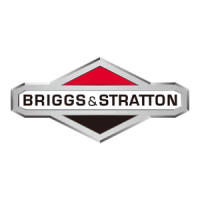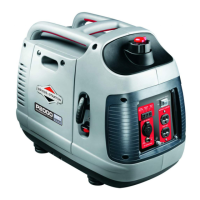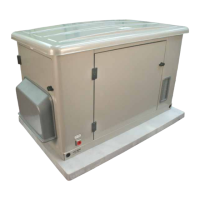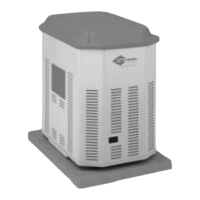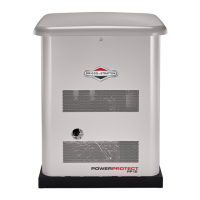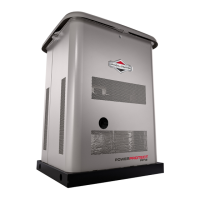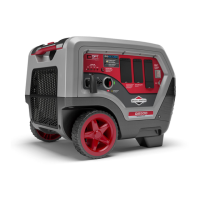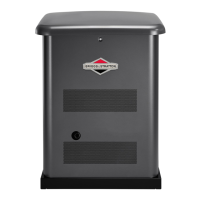5
WARNING Storage batteries give off explosive
hydrogen gas during recharging.
a long time after battery has been
charged. Slightest spark could ignite hydrogen
causing explosion resulting in death or serious
injury.
Battery electrolyte fluid contains acid and is
extremely caustic. Contact with battery fluid could
cause chemical burns resulting in serious injury.
• DO NOT allow any open flame, spark, heat, or lit
cigarette during and for several minutes after charging a
battery.
• Wear protective goggles, rubber apron, and rubber
gloves.
• DO NOT continue to charge a battery that becomes hot
or is fully charged.
• DO NOT leave battery unattended.
WARNING Fuel and its vapors are extremely
flammable and explosive which
could cause burns, fire or explosion
resulting in death or serious injury.
WHEN ADDING OR DRAINING FUEL
• Turn generator engine OFF and let it cool at least 2
minutes before removing fuel cap. Loosen cap slowly to
relieve pressure in tank.
• Fill or drain fuel tank outdoors.
• DO NOT overfill tank. Allow space for fuel expansion.
• If fuel spills, wait until it evaporates before starting engine.
• Keep fuel away from sparks, open flames, pilot lights,
heat, and other ignition sources.
• Check fuel lines, tank, cap and fittings frequently for
cracks or leaks. Replace if necessary.
• DO NOT light a cigarette or smoke.
WHEN STARTING EQUIPMENT
• Ensure spark plug, muffler, fuel cap, and air cleaner are
in place.
• DO NOT crank engine with spark plug removed.
WHEN OPERATING EQUIPMENT
• DO NOT operate this product inside any building,
carport, porch, mobile equipment, marine applications, or
enclosure.
• DO NOT tip engine or equipment at angle which causes
fuel to spill.
• DO NOT stop engine by moving choke control to
( ) position.
WHEN TRANSPORTING, MOVING OR REPAIRING
EQUIPMENT
• Transport/move/repair with fuel tank EMPTY or with fuel
shutoff valve OFF (0).
• DO NOT tip engine or equipment at angle which causes
fuel to spill.
• Disconnect spark plug wire.
WHEN STORING FUEL OR EQUIPMENT WITH FUEL IN
TANK
• Store away from furnaces, stoves, water heaters, clothes
dryers, or other appliances that have pilot light or other
ignition source because they could ignite fuel vapors.
WARNING Starter cord kickback (rapid
retraction) will pull hand and arm toward
engine faster than you can let go which
could cause broken bones, fractures,
bruises, or sprains resulting in serious injury.
• When starting engine, pull cord slowly until resistance is
felt and then pull rapidly to avoid kickback.
• NEVER start or stop engine with electrical devices
plugged in and turned on.
WARNING
Engine exhaust contains carbon monoxide,
a poisonous gas that could kill you in
minutes. You CANNOT smell it, see it, or
taste it. Even if you do not smell exhaust fumes, you
could still be exposed to carbon monoxide gas.
• Operate this product ONLY outside far away from
windows, doors and vents to reduce the risk of carbon
monoxide gas from accumulating and potentially being
drawn towards occupied spaces.
• Install battery-operated carbon monoxide alarms or
plug-in carbon monoxide alarms with battery back-up
according to the manufacturer’s instructions. Smoke
alarms cannot detect carbon monoxide gas.
• DO NOT run this product inside homes, garages,
basements, crawlspaces, sheds, or other partially-
enclosed spaces even if using fans or opening doors
and windows for ventilation. Carbon monoxide can
quickly build up in these spaces and can linger for hours,
even after this product has shut off.
• ALWAYS place this product downwind and point the
engine exhaust away from occupied spaces.
If you start to feel sick, dizzy, or weak while using this
may have carbon monoxide poisoning.

